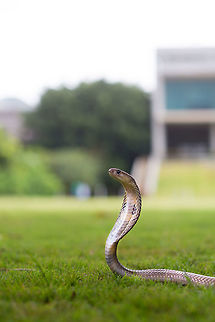![Indian Spectacled Cobra (Juvenile) Naja naja The Indian cobra (Naja naja) also known as the Spectacled cobra, Asian cobra or Binocellate cobra is a species of the genus Naja found in the Indian subcontinent (Pakistan, India) and a member of the "big four" species that inflict the most snakebites on humans in India. This snake is revered in Indian mythology and culture, and is often seen with snake charmers. It is now protected in India under the Indian Wildlife Protection Act (1972).<br />
<br />
Naja naja was first described by Swedish physician, zoologist, and botanist Carl Linnaeus in 1758. The generic name and the specific epithet naja is a Latinisation of the Sanskrit word nāgá (नाग) meaning "cobra".<br />
<br />
The Indian cobra or spectacled cobra, being common in South Asia, is referred to by a number of local names deriving from the root of Nag (नाग) (Hindi, Oriya, Marathi), Moorkan, മൂര്‍ഖന്‍ (Malayalam), Naya-නයා (Sinhalese), Nagu Pamu (Telugu),[8] Nagara Havu (Kannada), Naga Pambu or Nalla pambu (நாகப் பாம்பு/நல்ல பாம்பு) (Tamil) "Phetigom" (Assamese) and Gokhra (গোখরো) (Bengali).<br />
<br />
Geotagged,India,Indian cobra,Naja naja,indianspectacledcobra,juvenile,najanaja](https://s3.amazonaws.com/media.jungledragon.com/images/2613/34829_medium.jpg?AWSAccessKeyId=05GMT0V3GWVNE7GGM1R2&Expires=1767225610&Signature=G0L7qxx9woXh%2Bo0V%2BlmZbgVbQ68%3D)
Indian Spectacled Cobra (Juvenile) Naja naja
The Indian cobra (Naja naja) also known as the Spectacled cobra, Asian cobra or Binocellate cobra is a species of the genus Naja found in the Indian subcontinent (Pakistan, India) and a member of the "big four" species that inflict the most snakebites on humans in India. This snake is revered in Indian mythology and culture, and is often seen with snake charmers. It is now protected in India under the Indian Wildlife Protection Act (1972).
Naja naja was first described by Swedish physician, zoologist, and botanist Carl Linnaeus in 1758. The generic name and the specific epithet naja is a Latinisation of the Sanskrit word nāgá (नाग) meaning "cobra".
The Indian cobra or spectacled cobra, being common in South Asia, is referred to by a number of local names deriving from the root of Nag (नाग) (Hindi, Oriya, Marathi), Moorkan, മൂര്ഖന് (Malayalam), Naya-නයා (Sinhalese), Nagu Pamu (Telugu),[8] Nagara Havu (Kannada), Naga Pambu or Nalla pambu (நாகப் பாம்பு/நல்ல பாம்பு) (Tamil) "Phetigom" (Assamese) and Gokhra (গোখরো) (Bengali).

The Indian cobra also known as the Spectacled cobra, Asian cobra or Binocellate cobra is a species of the genus ''Naja'' found in the Indian subcontinent and a member of the "big four", the four species which inflict the most snakebites on humans in India. This snake is revered in Indian mythology and culture, and is often seen with snake charmers. It is now protected in India under the ''Indian Wildlife Protection Act'' .
